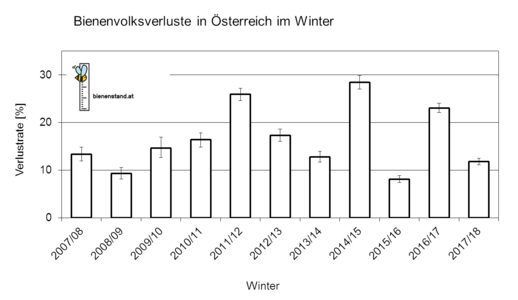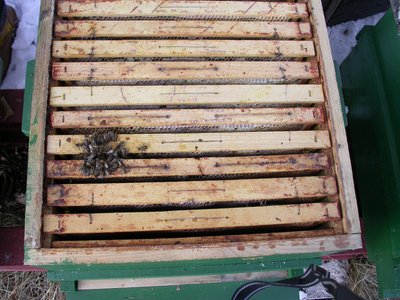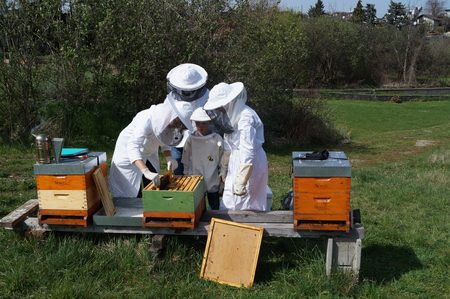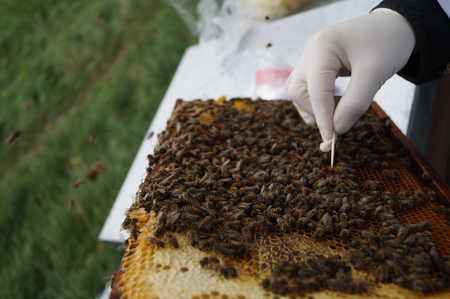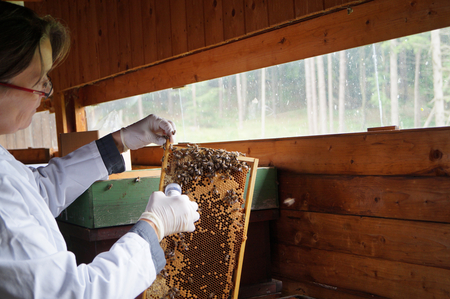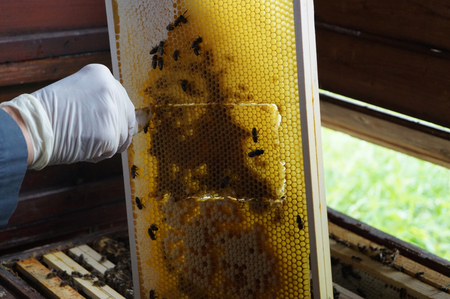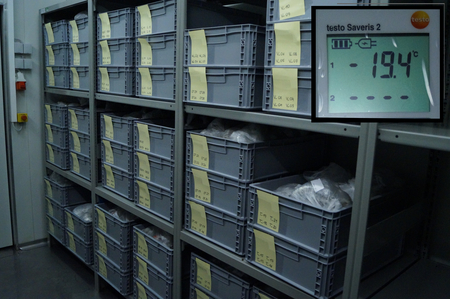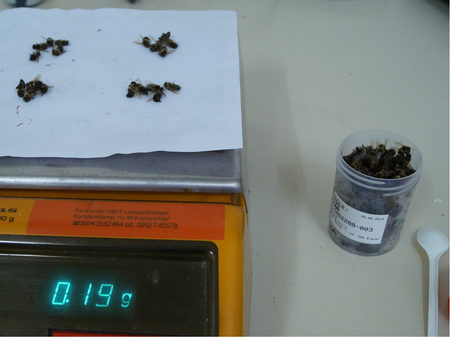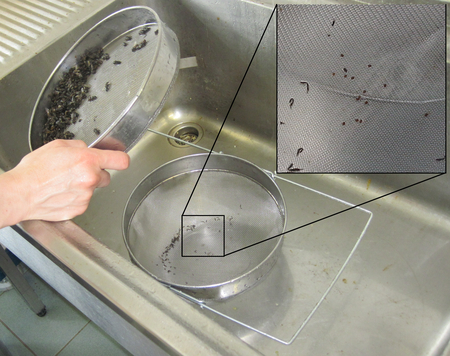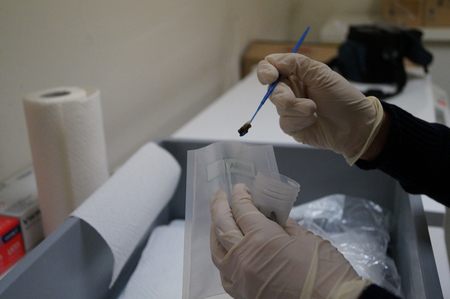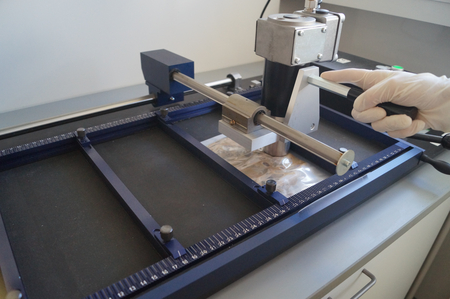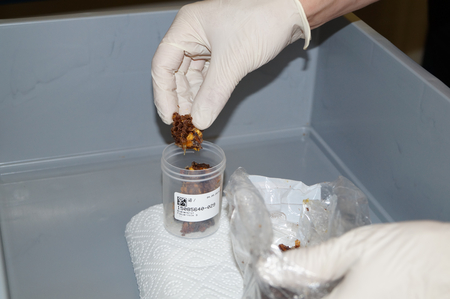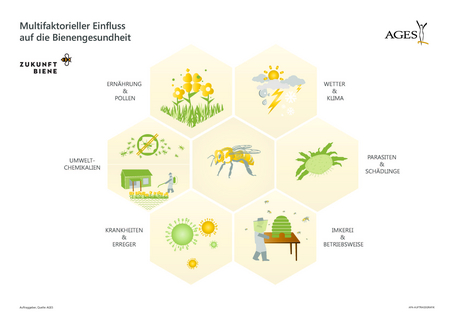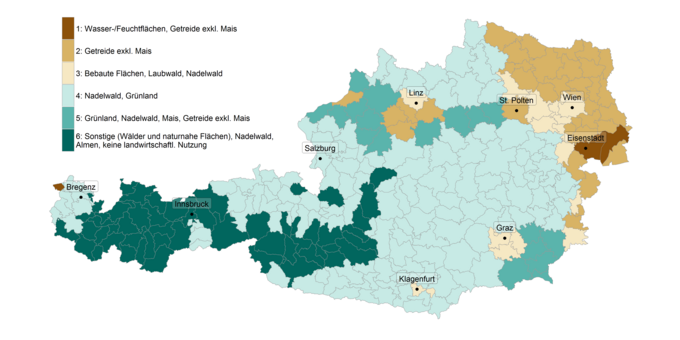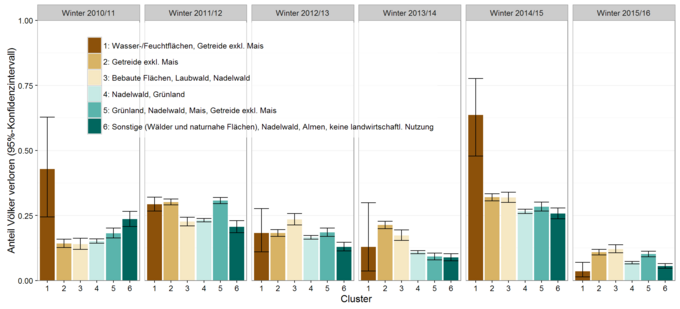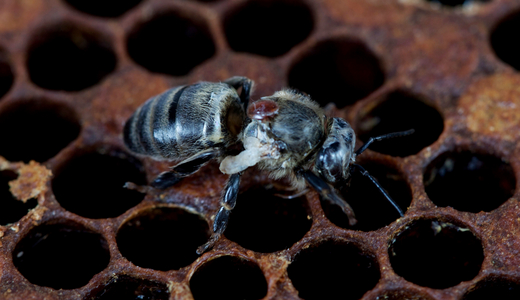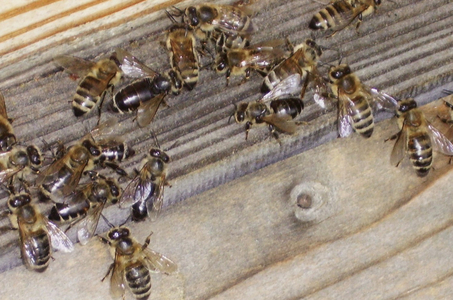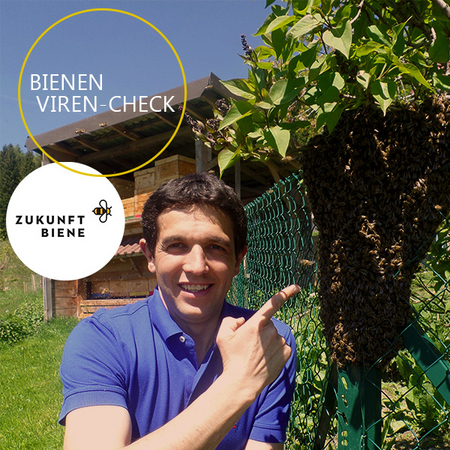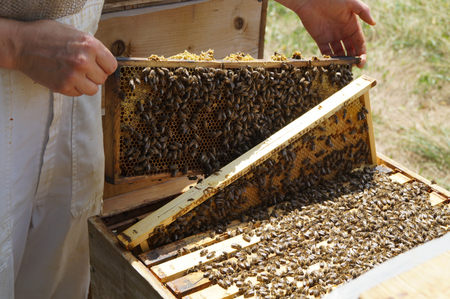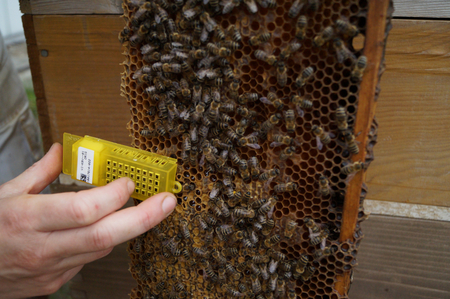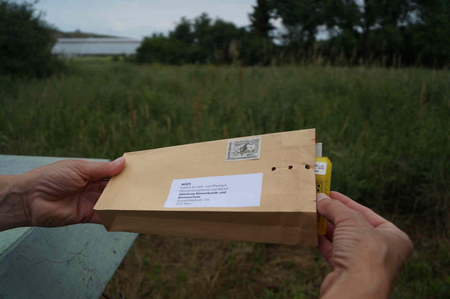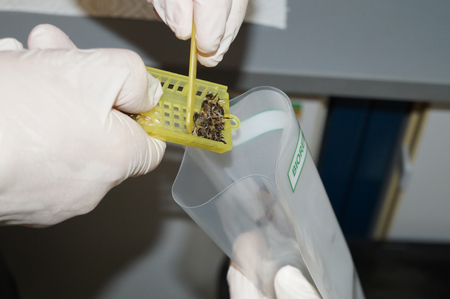Future bee
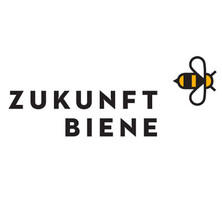
The research project "Future Bee" has investigated bee health in Austria and the influence of agricultural production, beekeeping and weather conditions on colony and bee losses. Beekeepers were intensively involved in order to work on practical issues relevant to beekeeping and agriculture and to be able to derive conclusions and measures from the results. Our work focused on land use and winter losses, research into the causes of colony and bee losses (observational study, suspected cases of poisoning), as well as tracht plant diversity (pollen analyses).
Initial situation
Healthy bees are essential for an intact nature and for agriculture in Austria. In Austria, there are around 27,000 beekeepers with a total of around 350,000 bee colonies. The number of bee colonies has been largely stable in Austria since 2003. Winter mortality varies greatly and has ranged between 8 and 28 percent in recent years. The majority of these losses could be compensated for in the respective following year by intensive efforts of beekeepers to multiply the surviving colonies. For bee conservation and beekeeping, collaboration among all sectors that influence the welfare of bees or benefit from their pollination activities is an important success factor. The findings of this project support stakeholders in keeping bee colonies healthy and reducing losses.
In order to investigate the causes of winter mortality and the effects of various influences on bee colonies, the research project "Zukunft Biene - Grundlagenforschungsprojekt zur Förderung des Bienenschutzes und der Bienengesundheit" (Future Bee - Basic Research Project to Promote Bee Protection and Bee Health) was commissioned and financed by the Federal Ministry of Agriculture, Forestry, Regions and Water Management (BML, formerly BMLRT) together with the federal provinces and the umbrella organization of Austrian beekeepers "Biene Österreich". Including the own contributions of the Karl-Franzens-University Graz as well as our own contributions, almost 2.5 million Euros were invested. The project was carried out by researchers of the University of Graz in cooperation with us. The overall project management was in the hands of Univ.-Prof. Dr. Karl Crailsheim from the University of Graz.
Results
The research project focused on winter mortality and major factors influencing bee health, such as Varroa mite, viruses and other diseases, weather, nutrition, beekeepers' operating methods and chemical substances from various sources (e.g. pesticides, biocides, veterinary drugs).
- The research results revealed a predominantly positive health status of the colonies studied. A clear correlation was found between winter losses and exposure to the Varroa mite, which lives as a parasite on honey bees and their brood.
- Climatic conditions, the environment of the apiary (vegetation and type of land use), beekeeping experience, colony strength and the age of the queen bees were also found to be influencing factors.
- Laboratory studies revealed the important and very specific function of the honeybee immune system and how it can be influenced by pesticides.
- Health and residue studies in the context of an Austria-wide study on the causes of winter mortality deepened the practical relevance of this project. There was no significant correlation between winter losses in the period studied and contamination of bee bread with pesticides in the previous fall. A positive correlation was found between winter losses and wing deformation virus infection.
- The result of the investigation of reported suspected poisoning cases showed that exposure to substances harmful to bees is a risk for bee losses.
Recommendations
From the results of the project, concrete recommendations can be derived both for beekeepers and for the various types of land use and for the use of pesticides to ward off various harmful organisms:
- The study shows that the varroa mite, in combination with certain bee viruses, had by far the greatest impact on bee health during the observation period. Timely, effective reduction of varroa infestation by the beekeeper is therefore an indispensable measure to ensure bee health and reduce winter losses.
- Other important supporting measures of the beekeeper are the choice of a good location, a good colony management and the wintering of strong bee colonies with young queens.
- The public, agriculture and forestry, planners and managers of public lands, and garden owners can support and encourage honey bees and other flower-visiting insects by doing their part to provide a diverse pollen and nectar supply from spring through fall and by reducing the risk of exposure to pesticides hazardous to bees as much as possible.
Follow-up project
Based on these results, the focal points of the investigation for the follow-up project "Zukunft Biene 2" were defined with the persons involved from science, the beekeepers' umbrella organization "Biene Österreich" and the Federal Ministry of Agriculture, Forestry, Regions and Water Management (BML). Since the Varroa mite in combination with viral diseases has the greatest impact on bee health, the follow-up project focuses on winter mortality, the occurrence of bee viruses and their impact on bee health in Austria (virus monitoring) and the development of new methods for virus diagnosis. This follow-up project, which is already underway, is funded by the BML, the provinces, the beekeepers' umbrella organization "Biene Österreich" and own funds from the University of Graz, the University of Veterinary Medicine and us.
Winter losses
In Austria, winter loss rates of honey bee colonies have been recorded for ten years. The results of the winters 2013/14 to 2016/17 are presented here. The loss rates of wintered colonies range from 8.1% (winter 2015/16) to 28.4% (winter 2014/15). From winter 2013/14 to winter 2016/17, 5227 records on 83,850 winterized colonies were examined over the entire study period for representativeness, geographic distribution of losses, accompanying symptoms of winter losses, and beekeeping management practices. Special attention was paid to the influence of Varroa treatment methods on winter mortality.
A negative correlation was found between the winter loss rate and the altitude of the colonies set up. It was also found that larger apiaries, with more than 50 colonies, had significantly lower losses than small apiaries with less than 20 colonies. Migratory beekeeping had no effect on winter loss rates. However, corn, as well as canola and buckwheat, represent a risk factor as hive plants.
Honeycomb hygiene measures, such as removing or replacing old, formerly incubated combs with new ones, showed no effect during the study period. In varroa control, formic acid was the most common method used in summer. The use of a sole formic acid long-term treatment showed clear advantages over a sole formic acid short-term treatment. Oxalic acid treatments for residual mitigation had no effect on overwintering success in the respective winter.
Treatment by hyperthermia as well as a single thymol treatment showed no clear positive or negative effects on the loss rates in the respective winter. Determination of varroa infestation yielded lower loss rates in three of four winters. Whether drone brood collection, which was used by more than 60% of the participants, actually produced overwintering success remains questionable. The use of other biotechnical methods (e.g., capture honeycomb, banning honeycomb, or total worker brood removal) proved to be positive for overwintering success, especially in the two winters with high losses.
Further information
Details on the current winter loss survey including online participation and deadlines:
Observational study
In this study, information on the clinical prevalence of the most important bee diseases was to be obtained by field inspection at a sample of about 190 apiaries distributed throughout Austria. Another objective was to record colony losses during the 2015/16 wintering period. For this purpose, the respective stands were inspected and sampled a total of three times.
The statistically significant factors influencing overwintering success include - in addition to the level of varroa infestation - the beekeeper's experience, the age of the queen and the colony strength in the fall. The probability that a colony died was higher the less experience the beekeeper had, the older the queen was and the weaker a colony was.
American foulbrood was found on 1.0% of the stands visited in summer 2015, none in fall 2015, and 0.5% in spring 2016. The corresponding values at colony level were 0.2%, 0.0%, and 0.1%.
Bag brood symptoms on bee brood were detectable on the first, second and third stand visits, respectively, on 1.3%, 0.2% and 0.2% of colonies and on 7.3%, 1.6% and 1.6% of stands. Similarly, limebrood symptoms were detected in 3.5%, 0.7%, and 2.0% of colonies and on 14.0%, 4.2%, and 10.4% of stands.
European foulbrood, Tropilaelaps mites and small hive beetle were not found. Symptoms of varroosis (varroa mites visible on bees, bees with crippled wings, varroa mites incorporated in cell covers) were found on about 22% of the apiaries during the first and second stand visits in 2015, and on 8.7% of the stands during the third stand visit in spring 2016.
Varroa mite was found on every apiary in the sampled colonies, with one exception. High varroa infestation values measured in September (> 3 % infestation of bees) are prognostically unfavorable for overwintering success. In case of high varroa infestation (disease pattern of varroosis), an infestation by the wing crippling virus is also to be expected.
The results of the surveys on the type and implementation of varroa control show the great variety of measures used and their different application times. The majority of beekeepers use combined measures for varroa control. In the case of non-drug measures, these were the removal of capped drone brood (just under 70% of the farms), total or partial brood removal (37%) - partly in combination with oxalic acid application - and, to a lesser extent, heat treatment. Among the medicinal measures, oxalic acid was the most frequently used active ingredient (98% of farms), followed by formic acid (85%) and thymol (23%). Other active substances were mentioned only in individual cases. The treatment concepts of the beekeepers in this module are very similar to the concepts mentioned in the COLOSS study in module 1. This suggests that both studies, which were conducted through different data collection methods, reflect the typical treatment concepts of Austrian beekeepers.
Formic acid and thymol were most frequently used in summer. Oxalic acid was mainly used in winter and to a lesser extent in summer. Oxalic acid was applied by drizzling on 82% of the stands, by evaporation on 36% of the stands and only rarely by spraying or fogging (7%). Formic acid was applied either as a short-term or long-term application with different evaporation systems. After performing the main mitigation with formic acid, oxalic acid or thymol preparations, there were no significant differences between the treatment groups in the median values of Varroa infestation of the bee samples during the second stand visit in September 2015. Thus, the goal of a strong reduction of varroa infestation before the emergence of winter bees was achieved with these three applied agents.
In the case of long-term application of formic acid for main mitigation, the amount administered had an influence on the varroa infestation of the bees in the following autumn. The efficacy of formic acid was significantly better in long-term treatment when more than 100 ml per colony had been applied. In the case of short-term application, the varroa infestation of the bees in autumn was significantly reduced with increasing amounts of formic acid applied per week. This means that a minimum quantity of 25-50 ml per colony and week is required for short-term application in order to achieve a corresponding effect.
Posthoc Studie
The aim of the posthoc study was to identify critical survival parameters and risk factors (pathogens, parasites, possible residues of active substances hazardous to bees) for colony losses with the aid of retrospective investigations of sample material (bee and bee bread samples) from colonies that had died or survived over the winter. The basis for this was the bee and bee bread samples taken from the living colonies during the stand visits of the second stand visit of the observation study in autumn 2015, as this was closest in time to the wintering period.
From 915 colonies, both a complete set of samples (fall: bee sample for varroa infestation determination, bee sample for pathogens, bee bread sample for residue analyses; spring: bee sample for pathogens) and information on overwintering results were available. From these 915 colonies, 210 colonies (60 dead over winter and 150 surviving) were selected for the posthoc study. All 60 dead colonies with a complete set of samples were included in the analyses in order to obtain a detailed picture of the health status of the dead colonies shortly before wintering. The studied group of 150 surviving colonies was selected after wintering out using a random number generator from the total of 855 surviving colonies with complete sample set.
The samples were examined for nosema infestation. In case of positive samples, molecular biology was used to differentiate between Nosema ceranae and Nosema apis.
For the three virus species ABPV, CBPV, and DWV, both qualitative and quantitative analysis of samples from the second visit were performed. DWV-positive samples were differentiated into the two virus types DWV-A and DWV-B.
Residue analytical testing of the bee bread included a broad spectrum of approximately 300 analytes. This allowed the determination of any exposure of the bee colonies to pesticides, biocides, veterinary medicines or pesticides, and legacy contaminants from long-ago applications.
Nosema ceranae was by far the predominant Nosema species. It was present in all 42 positive samples (20%) from the second visit and all 42 positive samples (26%) from the third visit. Nosema apis was detectable in only one each of the samples from the second and third visits. There was no significant difference between colonies that died over the winter and those that successfully overwintered in the proportion of Nosema-positive samples in the previous fall (17% of dead colonies; 21% of live colonies). There was also no significant difference in the amount of spores per bee between dead and live colonies.
As the virus testing of the fall 2015 bee samples for ABPV, CBPV, and DWV showed, there were significant differences in the proportion of infected colonies. ABPV was the most frequently detectable virus, followed by DWV and CBPV.
For ABPV, there were no significant differences in the proportion of positive samples between dead and surviving colonies. For DWV, the proportion of positive samples was significantly greater in colonies that died over the winter than in surviving colonies. For CBPV, the proportion of positive samples was higher in the surviving colonies than in the dead ones. What caused this unexpected result cannot be deduced from the data of the sample collective studied.
Multiple infections by more than one of the three examined pathogens or Nosema ceranae occurred in 90 of the 210 examined bee samples. The proportion of dead colonies for each pathogen was highest in the mating with DWV and lowest in the mating with CBPV. By far the highest winter losses (47%) were recorded in the pairing of DWV and ABPV. Those colonies with a double infection with ABPV and DWV died significantly more often than those infected with ABPV only.
In the residue tests for chemical substances (pesticides, biocides, veterinary drugs, substances from contaminated sites, etc.) on 210 bee bread samples from individual colonies, no residues were detectable in 42 samples (20%). A total of 48 analytes were detected in the residue-positive samples. The three most frequently detected active ingredients were, in descending order, the fungicide fludioxonil (62 positive samples), the synergist piperonyl butoxide (57 positive samples), and the insecticide and acaricide tau-fluvalinate (43 positive samples).
This was followed at a distance by the insecticides esfenvalerate (22 positive samples) and thiacloprid (21 positive samples). In this order, it is surprising that piperonyl butoxide was detected in 57 samples. Since this substance is used together with pyrethrum or pyrethroids in plant protection products, but also in biocidal products, it represents an exposure marker, even though pyrethrum could not be detected in any sample and pyrethroids in only a small number of the samples tested.
Of the four active ingredients covered by the EU partial ban on certain crops and forms of application, clothianidin and thiamethoxam were not detectable in any sample, imidacloprid in seven and fipronil in two samples (one sample per stand). Thus, of the 99 stands sampled, 7 (= 7%) had exposure to imidacloprid and 2 stands (= 2%) had exposure to fipronil. Of the metabolites of these active ingredients, the imidacloprid hydroxy metabolite was detectable in one sample and the imidacloprid olefin metabolite was detectable in three samples. Of clothianidin metabolites, TZMU was detectable in 13 samples and TZNG in one sample. The fipronil metabolite fipronil sulfone was not detectable in any sample. In isolated cases, active substances were also detectable in the bee bread that are not or no longer approved for plant protection purposes in the EU (bioallethrin, biphenyl, bromopropylate, chlorfenvinphos, DDD, DDT, dichlofluanid, permethrin, propargite, quinalphos and 4,4-methoxychlor). Possible sources of contamination in these cases include other uses (e.g., wood preservation, parasite and vermin control) or contaminated sites.
In a tested multivariate model, bee infestation with varroa mites in the fall of 2015 was the main factor influencing winter mortality in 2015/16 during the study period of the posthoc study.
In the overall interpretation of the results of the posthoc study, it must be taken into account, both with regard to the prevalences of the investigated pathogens and parasites and with regard to the determined pesticide residues, that the data only refer to the survey period autumn 2015. The following wintering period recorded the lowest winter losses since data recording began in 2007/08. Survey programs running over several years would be required to capture differences between years. This also applies to the question of an equilibrium shift in the occurrence of different virulent virus strains in the course of the years or depending on the varroa infestation and the implemented infestation-reducing measures.
In summary, the posthoc study showed on the whole a positive picture of the health status of the investigated bee colonies in Austria. The colonies represented in the posthoc study were free of symptoms of poisoning and the majority were also free of clinical symptoms of disease.
In the 210 bee samples examined, which had been taken in autumn 2015, the wing crippling virus (DWV), which is harmful to bees, was detectable with a significantly lower frequency than in previous surveys from Austria or European comparative data. Since infection with DWV is closely linked to the occurrence of varroosis - the symptom pattern of high varroa infestation - this result shows that a large proportion of beekeepers in the observation study had the varroa mite well under control in 2015/16. Another indication is also the low winter losses of this period.
No significant correlation was found between the pesticide load in the bee bread of the colonies studied in the fall of 2015 and subsequent winter losses in these colonies. In most cases, the pesticide load was significantly below the comparative values measured in cases of suspected poisoning.
In both the posthoc and the observational study, successful control of the Varroa mite emerged as a crucial factor for successful overwintering of the bee colonies. This gives us the opportunity to improve the effectiveness of varroa control through targeted, focused training measures and thus prevent winter losses.
Climate & Land Use
One focus of the work was the topic of land use and winter losses. The background of the question was the different high winter loss rates of bee colonies in different areas of Austria. The question to be answered was "Is there a correlation between winter losses of bee colonies and the type of land use?"
The data collected in this part of the project formed the basis for the investigations of the module "Epidemiological studies on winter mortality". Here it could be shown by means of complex model calculations that winter mortality shows a certain correlation with the prevailing climatic conditions, e.g. that the mean maximum temperature in the month of September correlates with increased loss rates in the then following winter.
However, the results do not provide the ability to make predictions about expected winter losses based on short-term climate observations. Land use clusters created using hierarchical cluster analysis (where clusters of different land uses were formed), were related to winter losses in these clusters: The results suggest that bee colonies kept in near-natural environments (forest, mountains) suffer lower winter losses. However, the results show a large variation between different years. A general correlation of cluster membership and winter mortality can therefore not be derived from the results.
Trachtpflanzen
Honey bees and wild bees need flower pollen for their supply of protein and fat, which they collect in the flight circle from the plants growing there. However, pollen varies in quality and value with respect to its protein, lipid, and vitamin content and the proportion of essential amino acids, as well as with respect to digestibility.
So far, there are no comprehensive studies on the seasonal and regional pollen sources used by bees and their diversity in Austria. The aim of the project module was to close this gap in order to obtain basic information on these questions, which are important for colony development and bee health. For this purpose, beekeepers were involved as voluntary samplers, so-called "Citizen Scientists".
The pollen analysis was initially carried out roughly by assigning colors to the pollen loads entered at fixed dates during the course of the year. In a second level, a light microscopic evaluation as well as the botanical identification of pollen-producing plants were carried out, which, however, could not be done in every case down to the species level.
At the first collection date, pollen from willow species clearly dominated. At the second date, pollen from willow and apple, pear and hawthorn, but also rape and horse chestnut were strongly represented. On the third date, maple dominated, followed by canola, other cruciferous plants, and various buttercup relatives. From the fourth collection date, white clover, plantain, mustard and red clover were increasingly used by bees as pollen sources. The plantain species and white clover then remained dominant until the 7th and 8th collection dates, respectively. From the 7th date onwards, various late flowering composites, mustard, phacelia and buckwheat were also heavily collected by the bees. At the end of the season on the 9th date, ivy pollen was dominant in both years.
Of special interest were the greenings with Phacelia tanacetifolia, Sinapis spp., Fagopyrum spp. and other representatives of the Brassicaceae family, flowering in late summer and well into fall. These are seen critically by parts of the beekeepers, since due to the extension of the brood activity problems with the bee health (extension of the reproduction period of the Varroa mite, dysentery, Nosema) could arise and the overwintering success could be influenced. Here it was shown that there are apiaries where the pollen of the mentioned plants plays a role in the late summer pollen supply, as well as apiaries where this is not the case.
Of particular interest in the evaluation of a site in terms of pollen diversity is the comparison between rural and urban areas. This question helps us understand which land use types best provide pollen to honey bees and other pollinators. Our study provides only exemplary results due to the relatively few apiaries studied in urban areas, but they support the assumption that urban sites are good pollen habitats.
In any case, the quality of the individual pollen must also be taken into account, since the pollen of individual plants, such as that of the sweet chestnut, has a significantly higher nutritional value for honey bees than many other pollen types. The pollen varieties that, according to our research, are most often found approximately in pure form in the collected material should be examined for their nutritional value for bees. This could give beekeepers the opportunity to take countermeasures if necessary and ensure an appropriately balanced food supply.
Suspected poisoning
Within the framework of "Zukunft Biene", a "Bee Health and Exposure Monitoring in Cases of Suspected Poisoning" was carried out in 2014-2016. The project module deals with acute cases of suspected poisoning, where the causes of colony losses and bee damage are clarified by residue testing. Unlike in the research projects MELISSA 2009-2011 and the bee exposure monitoring 2012 and 2013, the proven exposure of bees to the active substances clothianidin, imidacloprid and thiamethoxam has largely ceased, which can be attributed to the partial ban on certain neonicotinoids.
| Project | Year | Stands exposed | Stands not exposed | Total stands | Percent Stands exposed |
| MELISSA | 2009 | 25 | 2 | 27 | 93 % |
| MELISSA | 2010 | 66 | 27 | 93 | 71 % |
| MELISSA | 2011 | 71 | 66 | 137 | 52 % |
| Exposure monitoring | 2012 | 21 | 20 | 41 | 51 % |
| Exposure monitoring | 2013 | 14 | 60 | 74 | 19 % |
| Future bee | 2014 | 9 | 49 | 58 | 16 % |
| Future bee | 2015 | 5 | 23 | 28 | 18 % |
| Future bee | 2016 | 7 | 29 | 36 | 19 % |
Honey bees can come into contact with various chemical substances inside and outside the hive. These may originate from the application of veterinary medicines (e.g. varroa control agents), plant protection products or biocides. However, they can also originate from previously used and approved applications, traces of which can still be detected in the environment today. In the following, all these substances are grouped under the term "pesticides". In the course of their flight and collection activities, bees can come into contact with them directly, but also indirectly via the material they collect (nectar, honeydew, pollen, water).
The content of the module was to examine reported bee damage and colony losses with suspected poisoning for pesticide residues. In cases of winter and late summer/autumn losses or in cases of bee outrages, additional health examinations for Varroa, Nosema and American foulbrood were carried out at our Bee Science and Bee Protection Department. Affected beekeepers could report such cases to us and have the samples examined free of charge. The residue analyses were carried out at PTRL Europe GmbH (Germany). The methods used detected around 300 substances, including selected metabolites of insecticidal active ingredients.
The test material (bees, bee bread, pollen pellets, honeycomb or mid-wall samples) was sent in by beekeepers or taken by authorities or by our staff in the course of stand visits.
In the project period 2014-2016, 145 apiaries were reported as suspected poisoned, 6 of them as suspected outrages (= malicious damage to property). From 122 stands, a total of 194 samples could be examined for residues. For 23 stands this was not possible, because either no test material was available or Varroosis or American foulbrood had been determined as causes of the colony losses.
The majority of the suspected poisoning reports came from Upper and Lower Austria, Styria, Burgenland and Carinthia. Isolated reports were received from Tyrol, Vorarlberg and Vienna, and no reports were received from Salzburg. In terms of time, most reports were assigned to the period spring to summer (87 stands), followed by the wintering period (37 stands), the late summer-autumn period (15 stands) and the suspected cases of outrages (6 stands).
In the reported suspected poisoning cases from the spring to autumn periods, the damage symptoms were mostly bee losses limited in time and quantity. These resulted in losses in honey yield and the production of young colonies, but rarely led to colony losses. The active substances clothianidin, imidacloprid and fipronil, which are hazardous to bees and are covered by the EU partial ban in various crops, were detected in a small number of samples. In these cases, there is a probability bordering on certainty that the bee damage that occurred was related to the exposure detected. Thiamethoxam was not detectable in any sample. Thus, in a multi-year comparison, the proportion of exposed apiaries for these active substances covered by the EU partial ban has significantly reduced from 93 % in 2009 (results of the "MELISSA" project) to the values between 16 % and 19 % determined in the "Zukunft Biene" project for the years 2014-2016.
In addition to the mentioned substances, some other insecticides hazardous to bees (e.g. lambda-cyhalothrin, chlorpyrifos-ethyl, cypermethrin and others) as well as fungicides, herbicides, some metabolites and varroacides were detectable in a small number of samples in different frequencies and concentrations.
The substances most frequently detected in the 194 samples examined were, in descending order: thiacloprid (42 ×), tau-fluvalinate (29 ×), piperonyl butoxide (25 ×), tebuconazole (22 ×), azoxystrobin (18 ×), biphenyl (16 ×), cyprodinil (14 ×), myclobutanil (11 ×), and spiroxamine (10 ×). All other substances were detected in less than 10 samples.
The spectrum of active substances detected is an indication that they originate from different sources of exposure (veterinary drugs currently used or used in previous years, pesticides, biocides, or ubiquitous contaminants, respectively). In cases of suspected bee abuse, severe total losses of bee colonies were observed in some cases, which could also be partially confirmed by residue analysis. The bee-hazardous substances detected in such cases (e.g. lambda-cyhalothrin, dichlorvos, chlorpyrifos-ethyl, cypermethrin, cyfluthrin) or the synergist piperonyl butoxide, which was found in high concentrations in some cases, are or were components of plant protection products and pesticides (biocides). It is not known how the bee colonies came into contact with them or were brought into contact with them.
During the wintering period, high colony losses were mostly reported in cases with suspected poisoning. Residue tests were negative in most cases and active substances hazardous to bees were detectable only in isolated cases. The health examinations frequently revealed varroasis - in a few cases also American foulbrood - as a very probable cause for the death of the colonies.
In the overall view, the results of this part of the project clearly show that colony losses and bee damage occur at different times and can also have different causes. In order to achieve an improvement of the situation for the bees and a reduction of colony and bee losses in the future, different approaches to the solution of occurring problems - depending on the determined cause and its weighting - are also necessary.
Future bee 2 - virus monitoring
The Federal Ministry of Agriculture, Forestry, Regions and Water Management (BML) has approved a follow-up project to "Zukunft Biene" called "Zukunft Biene 2 - Basic Research Project to Promote Bee Protection and Bee Health". The project focus is on the different bee viruses, but data on winter losses of Austrian beekeepers will continue to be collected. "Zukunft Biene 2" is designed to a large extent as a "Citizen Science" project. Involving beekeepers from all over Austria as amateur researchers, the health status of domestic honey bees in their different living environments is being investigated. With the cooperation of the population, scientific questions can be collected and processed more comprehensively in a shorter period of time.
Initial situation
According to current scientific knowledge, bee viruses such as wing deformation virus and acute bee paralysis virus are partly responsible for high winter losses. But other viruses, such as the sac brood virus or the chronic bee paralysis virus, also cause great hardship to bee colonies. Unfortunately, we currently only have selective knowledge about the occurrence and frequency of these bee viruses in Austria. Up to now, investigations of viruses have usually only been carried out when damage has already been done to the bee colony. Research results from the USA and neighboring European countries have shown that many viruses occur just as frequently in colonies that appear inconspicuous as in those that are clearly damaged.
Project goal
Within the framework of "Zukunft Biene", an overview of the frequency of three bee viruses in Austria has already been obtained. This knowledge will be deepened in our multi-year Austrian virus monitoring and the spectrum of investigation will be extended by another four viruses. Vetmeduni Vienna will test innovative approaches to improve virus diagnostics in honey bees. Until now, viral infections in honey bees have been diagnosed by detecting the viral genome using "polymerase chain reaction" (PCR). These PCR test methods are very time-consuming and expensive and always detect only one virus species. The aim of the module is therefore to develop a virus test that detects viral antigens (proteins). The test procedures to be developed are cost-effective and can be automated, so that in the future beekeepers will be able to test the health of their colonies and react to viral infestations with targeted measures without great financial expense. The University of Graz will continue the COLOSS study on winter losses in Austria. Thus, at the conclusion of "Zukunft Biene 2", 14 years of continuous winter loss data will be available, from which important conclusions about trends and cycles can be drawn. In addition, important questions about the economic significance of winter losses, methods of winter loss surveys and the problems and expectations of young beekeepers will be scientifically addressed.
Research topic: bee health Project name: Zukunft Biene 2 - Basic research project to promote bee protection and bee health Project duration: 12/2017 to 09/2021 Project management: Dr. Robert Brodschneider, University of Graz Project consortium: Karl-Franzens-University Graz (Institute of Zoology), University of Veterinary Medicine Vienna (Institute of Virology), AGES - Austrian Agency for Health and Food Safety GmbH (Department of Apiology and Bee Protection, Department of Molecular Biology, Department of Statistics) Project funding: Federal Ministry of Agriculture, Forestry, Regions and Water Management (BML), federal provinces and beekeepers' umbrella organization Biene Österreich as well as own funds of Karl-Franzens-University Graz, University of Veterinary Medicine Vienna and AGES.
Bee Virus Monitoring on the Citizen Science Platform
We are pleased to announce that the project fulfills the Citizen Science quality criteria on the platform Österreich forscht. Many thanks to the whole project team:
Citizen Scientists (sample and data collection): 200 beekeepers from all over Austria Project management "virus monitoring" (communication, reporting): Linde Morawetz Project implementation (elaboration, preparation materials): Katharina Etter, Irmgard Derakhshifar (retired), Hemma Köglberger, Rudolf Moosbeckhofer (retired) Analytical laboratory (method development, analysis): Adi Steinrigl, Sigrid Träger Statistics (statistical analysis): Antonia Griesbacher Project management overall project "Future Bee 2" (project management): Robert Brodschneider Cooperation partner "Future Bee 2" (consulting): Robert Brodschneider, Benjamin Lamp

Successful start of virus monitoring for beekeepers
What are the most common bee viruses in Austria and are these viruses associated with high winter losses of domestic bee colonies? To answer these questions, 200 beekeepers from all over Austria are collaborating as Citizen Scientists in the "Zukunft Biene" follow-up project. The apiaries for this study were selected at random from voluntary reports as a result of our Facebook campaign and an appeal in the magazine "Bienen aktuell" and from "Biene Österreich".
In "Zukunft Biene 2", the colonies of 200 apiaries throughout Austria will be examined for three years free of charge for the seven most important bee viruses in project module A. The aim is to answer the following question. The question to be answered is: Which are the most common bee viruses in Austria and are they associated with high winter losses? At the same time, basic and necessary information about bee viruses is being collected.
In September 2018, amateur researchers sent bee samples from their apiaries. 198 packages were received in the process. Thus, 99% of the selected participants successfully completed the first of three sampling sessions.
The sampling was done by the beekeepers themselves, the materials and instructions were provided to them by us. They each sampled five of their colonies by filling five queen cages with about ten bees each. They then provided detailed information about their operation in a questionnaire.
Many of the participants performed a voluntary additional task: they looked through the sample colonies for disease symptoms that may be related to virus infestation and also entered these observations in the questionnaire.
The queen cages, together with the questionnaire, were sent by mail to the Bee Science and Bee Protection Department. Once there, the packages were immediately deep-frozen, thus killing the bees quickly and gently.
The virus level of the bees sent in will be determined in the next few months and announced to the beekeepers.
What do participating beekeepers have to do?
- Select an apiary with at least five colonies and inform us about it.
- Collect and send bee samples from selected colonies on your own (material and instructions will be provided by us)
- Answering a short questionnaire about the farm and the apiary
- Announce overwintering results of the sampled colonies and the other colonies of the stand in the following spring.
What do participating beekeepers get out of the project?
- Three years of free virus check (1 time per year)
- Annual sending of the virus results in the sampled bee colonies
- Information about yearly changes in virus occurrence
- A sharpened, fact-based picture of the health status of their colonies
- The certainty that as a researcher you are doing something useful to keep your bee colonies healthy.
Further information is available on the project homepage. If you have any questions about virus monitoring, please contact our Bee Science and Bee Protection Department at the email address: virenmonitoring@ages.at.
Last updated: 10.10.2023
automatically translated
